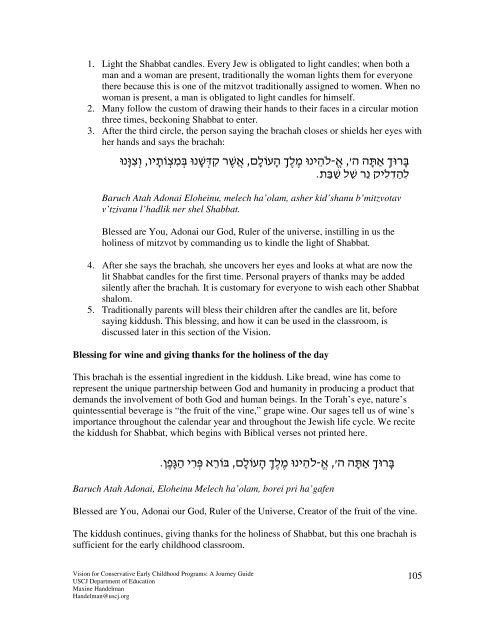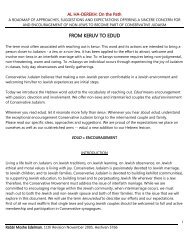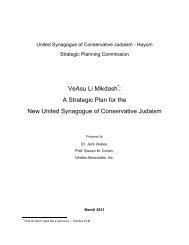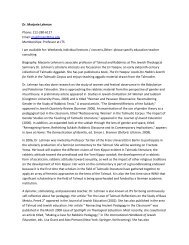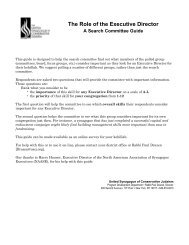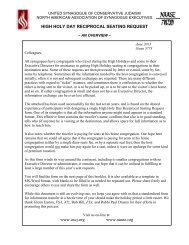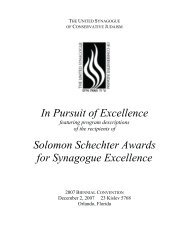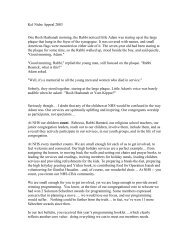Vision for Conservative Early Childhood Programs: A Journey Guide
Vision for Conservative Early Childhood Programs: A Journey Guide
Vision for Conservative Early Childhood Programs: A Journey Guide
Create successful ePaper yourself
Turn your PDF publications into a flip-book with our unique Google optimized e-Paper software.
1. Light the Shabbat candles. Every Jew is obligated to light candles; when both a<br />
man and a woman are present, traditionally the woman lights them <strong>for</strong> everyone<br />
there because this is one of the mitzvot traditionally assigned to women. When no<br />
woman is present, a man is obligated to light candles <strong>for</strong> himself.<br />
2. Many follow the custom of drawing their hands to their faces in a circular motion<br />
three times, beckoning Shabbat to enter.<br />
3. After the third circle, the person saying the brachah closes or shields her eyes with<br />
her hands and says the brachah:<br />
,$$<br />
, <br />
% 7 " @ () &. %<br />
% <br />
Baruch Atah Adonai Eloheinu, melech ha’olam, asher kid’shanu b’mitzvotav<br />
v’tzivanu l’hadlik ner shel Shabbat.<br />
Blessed are You, Adonai our God, Ruler of the universe, instilling in us the<br />
holiness of mitzvot by commanding us to kindle the light of Shabbat.<br />
4. After she says the brachah, she uncovers her eyes and looks at what are now the<br />
lit Shabbat candles <strong>for</strong> the first time. Personal prayers of thanks may be added<br />
silently after the brachah. It is customary <strong>for</strong> everyone to wish each other Shabbat<br />
shalom.<br />
5. Traditionally parents will bless their children after the candles are lit, be<strong>for</strong>e<br />
saying kiddush. This blessing, and how it can be used in the classroom, is<br />
discussed later in this section of the <strong>Vision</strong>.<br />
Blessing <strong>for</strong> wine and giving thanks <strong>for</strong> the holiness of the day<br />
This brachah is the essential ingredient in the kiddush. Like bread, wine has come to<br />
represent the unique partnership between God and humanity in producing a product that<br />
demands the involvement of both God and human beings. In the Torah’s eye, nature’s<br />
quintessential beverage is “the fruit of the vine,” grape wine. Our sages tell us of wine’s<br />
importance throughout the calendar year and throughout the Jewish life cycle. We recite<br />
the kiddush <strong>for</strong> Shabbat, which begins with Biblical verses not printed here.<br />
*> 0 %" @ () &. %<br />
Baruch Atah Adonai, Eloheinu Melech ha’olam, borei pri ha’gafen<br />
Blessed are You, Adonai our God, Ruler of the Universe, Creator of the fruit of the vine.<br />
The kiddush continues, giving thanks <strong>for</strong> the holiness of Shabbat, but this one brachah is<br />
sufficient <strong>for</strong> the early childhood classroom.<br />
<strong>Vision</strong> <strong>for</strong> <strong>Conservative</strong> <strong>Early</strong> <strong>Childhood</strong> <strong>Programs</strong>: A <strong>Journey</strong> <strong>Guide</strong><br />
USCJ Department of Education<br />
Maxine Handelman<br />
Handelman@uscj.org<br />
105


